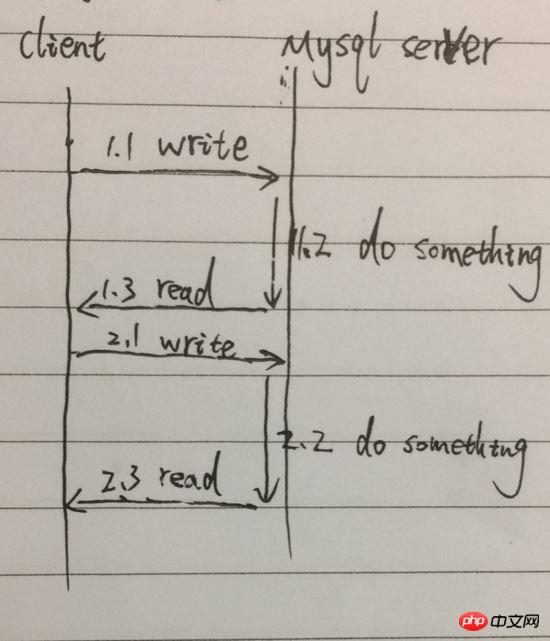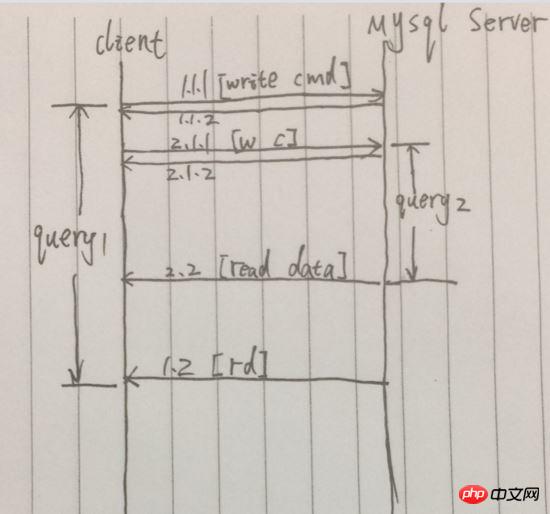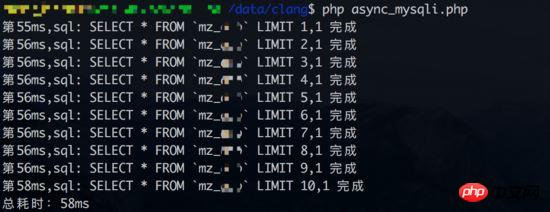PHP concurrency example about querying MySQL (picture)
This article mainly introduces the example code of PHP concurrent query of MySQL. The editor thinks it is quite good. Now I will share it with you and give it as a reference. Let’s follow the editor to take a look.
I have been studying PHP recently and I like it very much. I encountered the problem of concurrent query of MySQL in PHP. I studied it and left a note by the way:
Synchronization Query
This is our most common calling mode. The client calls Query[function], initiates a query command, waits for the result to be returned, reads the result; then sends the second query command, and waits for the result to be returned. , read the result. The total time taken will be the sum of the time of the two queries. Simplify the process, for example, as shown in the figure below:

As shown in the figure, from 1.1 to 1.3 is the call of a Query [function]. Two queries require serialization of 1.1, 1.2, 1.3, 2.1, 2.2, 2.3, especially 1.2 and 2.2 will block waiting, and the process cannot do other things.
The advantage of synchronous calling is that it conforms to our intuitive thinking and is simple to call and process. The disadvantage is that the process is blocked waiting for the result to be returned, adding extra running time.
If there are multiple query requests, or the process has other things to deal with, then it is obviously possible to make reasonable use of the waiting time and improve the processing capacity of the process.
Split
Now, we break the Query[function] into pieces. The client returns immediately after 1.1. The client skips 1.2 and has data in 1.3. Read the data after reaching it. In this way, the process is freed from the original 1.2 stage and can do more things, such as...initiate another SQL query [2.1], have you seen the prototype of concurrent query?
Concurrent query
Compared to the synchronous query, the next query is initiated after the previous query is completed. Concurrent queries can be initiated immediately after the previous query request is initiated. Initiate the next query request. Simplify the process, as shown below:

Example picture, after successfully sending the request in 1.1.1, [1.1.2] is returned immediately, and the final query result is returned in Distant 1.2. However, between 1.1.1 and 1.2, another query request was initiated. During this time period, two query requests were initiated at the same time. 2.2 arrived before 1.2, so the total time of the two queries was only equivalent to The time of the first query.
The advantage of concurrent query is that it can improve the utilization rate of the process, avoid blocking and waiting for the server to process the query, and shorten the time of multiple queries. But the disadvantages are also obvious. To initiate N concurrent queries, you need to establish N database links. For applications with database connection pools, this situation can be avoided.
Degeneration
Ideally, we want to concurrently run N queries, and the total time consumption is equal to the query with the longest query time. But it is also possible that concurrent queries will [degenerate] into [synchronous queries]. What? In the example diagram, if 1.2 is returned before 2.1.1, then the concurrent query will [degenerate] into [synchronous query], but the cost will be higher than that of synchronous query.
Multiplexing
Initiate query1
Initiate query2
Initiate query3
- ##…………
- Waiting for query1, query2, query3
- Read query2 results
- Read query1 results
- Read query3 results
PHP implements concurrent query MySQL
PHP's mysqli (mysqlnd driver) provides multiplexed polling IO (mysqli_poll) and asynchronous query (MYSQLI_ASYNC, mysqli_reap_async_query), Use these two features to implement concurrent queries, sample code:<?php
$sqls = array(
'SELECT * FROM `mz_table_1` LIMIT 1000,10',
'SELECT * FROM `mz_table_1` LIMIT 1010,10',
'SELECT * FROM `mz_table_1` LIMIT 1020,10',
'SELECT * FROM `mz_table_1` LIMIT 10000,10',
'SELECT * FROM `mz_table_2` LIMIT 1',
'SELECT * FROM `mz_table_2` LIMIT 5,1'
);
$links = [];
$tvs = microtime();
$tv = explode(' ', $tvs);
$start = $tv[1] * 1000 + (int)($tv[0] * 1000);
// 链接数据库,并发起异步查询
foreach ($sqls as $sql) {
$link = mysqli_connect('127.0.0.1', 'root', 'root', 'dbname', '3306');
$link->query($sql, MYSQLI_ASYNC); // 发起异步查询,立即返回
$links[$link->thread_id] = $link;
}
$llen = count($links);
$process = 0;
do {
$r_array = $e_array = $reject = $links;
// 多路复用轮询IO
if(!($ret = mysqli_poll($r_array, $e_array, $reject, 2))) {
continue;
}
// 读取有结果返回的查询,处理结果
foreach ($r_array as $link) {
if ($result = $link->reap_async_query()) {
print_r($result->fetch_row());
if (is_object($result))
mysqli_free_result($result);
} else {
}
// 操作完后,把当前数据链接从待轮询集合中删除
unset($links[$link->thread_id]);
$link->close();
$process++;
}
foreach ($e_array as $link) {
die;
}
foreach ($reject as $link) {
die;
}
}while($process < $llen);
$tvs = microtime();
$tv = explode(' ', $tvs);
$end = $tv[1] * 1000 + (int)($tv[0] * 1000);
echo $end - $start,PHP_EOL;#ifndef PHP_WIN32
#define php_select(m, r, w, e, t) select(m, r, w, e, t)
#else
#include "win32/select.h"
#endif
/* {{{ mysqlnd_poll */
PHPAPI enum_func_status
mysqlnd_poll(MYSQLND **r_array, MYSQLND **e_array, MYSQLND ***dont_poll, long sec, long usec, int * desc_num)
{
struct timeval tv;
struct timeval *tv_p = NULL;
fd_set rfds, wfds, efds;
php_socket_t max_fd = 0;
int retval, sets = 0;
int set_count, max_set_count = 0;
DBG_ENTER("_mysqlnd_poll");
if (sec < 0 || usec < 0) {
php_error_docref(NULL, E_WARNING, "Negative values passed for sec and/or usec");
DBG_RETURN(FAIL);
}
FD_ZERO(&rfds);
FD_ZERO(&wfds);
FD_ZERO(&efds);
// 从所有mysqli链接中获取socket链接描述符
if (r_array != NULL) {
*dont_poll = mysqlnd_stream_array_check_for_readiness(r_array);
set_count = mysqlnd_stream_array_to_fd_set(r_array, &rfds, &max_fd);
if (set_count > max_set_count) {
max_set_count = set_count;
}
sets += set_count;
}
// 从所有mysqli链接中获取socket链接描述符
if (e_array != NULL) {
set_count = mysqlnd_stream_array_to_fd_set(e_array, &efds, &max_fd);
if (set_count > max_set_count) {
max_set_count = set_count;
}
sets += set_count;
}
if (!sets) {
php_error_docref(NULL, E_WARNING, *dont_poll ? "All arrays passed are clear":"No stream arrays were passed");
DBG_ERR_FMT(*dont_poll ? "All arrays passed are clear":"No stream arrays were passed");
DBG_RETURN(FAIL);
}
PHP_SAFE_MAX_FD(max_fd, max_set_count);
// select轮询阻塞时间
if (usec > 999999) {
tv.tv_sec = sec + (usec / 1000000);
tv.tv_usec = usec % 1000000;
} else {
tv.tv_sec = sec;
tv.tv_usec = usec;
}
tv_p = &tv;
// 轮询,等待多个IO可读,php_select是select的宏定义
retval = php_select(max_fd + 1, &rfds, &wfds, &efds, tv_p);
if (retval == -1) {
php_error_docref(NULL, E_WARNING, "unable to select [%d]: %s (max_fd=%d)",
errno, strerror(errno), max_fd);
DBG_RETURN(FAIL);
}
if (r_array != NULL) {
mysqlnd_stream_array_from_fd_set(r_array, &rfds);
}
if (e_array != NULL) {
mysqlnd_stream_array_from_fd_set(e_array, &efds);
}
// 返回可操作的IO数量
*desc_num = retval;
DBG_RETURN(PASS);
}Concurrent query operation results
In order to see it more intuitively As a result, I found a table with 130 million data volumes and which has not been optimized for operation. 

Comparison of multiple queries with shorter query times
Use multiple sql queries with shorter query times for comparison
Concurrent query test 1 Result (database link time is also counted):

Result of synchronous query (database link time is also counted):

Test 2 results of concurrent query (database link time is not counted):

Judging from the results, concurrent query test 1 did not benefit. From the perspective of synchronous queries, each query takes about 3-4ms. But if the database connection time is not included in the statistics (synchronous query only has one database connection), the advantages of concurrent query can be reflected again.
Conclusion
Here we discussed the implementation of concurrent query MySQL in PHP, and intuitively understood the advantages and disadvantages of concurrent query from the experimental results. The time to establish a database connection still accounts for a large proportion of an optimized SQL query. #There is no connection pool, what is your use?
The above is the detailed content of PHP concurrency example about querying MySQL (picture). For more information, please follow other related articles on the PHP Chinese website!

Hot AI Tools

Undresser.AI Undress
AI-powered app for creating realistic nude photos

AI Clothes Remover
Online AI tool for removing clothes from photos.

Undress AI Tool
Undress images for free

Clothoff.io
AI clothes remover

Video Face Swap
Swap faces in any video effortlessly with our completely free AI face swap tool!

Hot Article

Hot Tools

Notepad++7.3.1
Easy-to-use and free code editor

SublimeText3 Chinese version
Chinese version, very easy to use

Zend Studio 13.0.1
Powerful PHP integrated development environment

Dreamweaver CS6
Visual web development tools

SublimeText3 Mac version
God-level code editing software (SublimeText3)

Hot Topics
 1664
1664
 14
14
 1422
1422
 52
52
 1316
1316
 25
25
 1267
1267
 29
29
 1239
1239
 24
24
 MySQL and phpMyAdmin: Core Features and Functions
Apr 22, 2025 am 12:12 AM
MySQL and phpMyAdmin: Core Features and Functions
Apr 22, 2025 am 12:12 AM
MySQL and phpMyAdmin are powerful database management tools. 1) MySQL is used to create databases and tables, and to execute DML and SQL queries. 2) phpMyAdmin provides an intuitive interface for database management, table structure management, data operations and user permission management.
 The Compatibility of IIS and PHP: A Deep Dive
Apr 22, 2025 am 12:01 AM
The Compatibility of IIS and PHP: A Deep Dive
Apr 22, 2025 am 12:01 AM
IIS and PHP are compatible and are implemented through FastCGI. 1.IIS forwards the .php file request to the FastCGI module through the configuration file. 2. The FastCGI module starts the PHP process to process requests to improve performance and stability. 3. In actual applications, you need to pay attention to configuration details, error debugging and performance optimization.
 Explain the purpose of foreign keys in MySQL.
Apr 25, 2025 am 12:17 AM
Explain the purpose of foreign keys in MySQL.
Apr 25, 2025 am 12:17 AM
In MySQL, the function of foreign keys is to establish the relationship between tables and ensure the consistency and integrity of the data. Foreign keys maintain the effectiveness of data through reference integrity checks and cascading operations. Pay attention to performance optimization and avoid common errors when using them.
 Compare and contrast MySQL and MariaDB.
Apr 26, 2025 am 12:08 AM
Compare and contrast MySQL and MariaDB.
Apr 26, 2025 am 12:08 AM
The main difference between MySQL and MariaDB is performance, functionality and license: 1. MySQL is developed by Oracle, and MariaDB is its fork. 2. MariaDB may perform better in high load environments. 3.MariaDB provides more storage engines and functions. 4.MySQL adopts a dual license, and MariaDB is completely open source. The existing infrastructure, performance requirements, functional requirements and license costs should be taken into account when choosing.
 SQL vs. MySQL: Clarifying the Relationship Between the Two
Apr 24, 2025 am 12:02 AM
SQL vs. MySQL: Clarifying the Relationship Between the Two
Apr 24, 2025 am 12:02 AM
SQL is a standard language for managing relational databases, while MySQL is a database management system that uses SQL. SQL defines ways to interact with a database, including CRUD operations, while MySQL implements the SQL standard and provides additional features such as stored procedures and triggers.
 How does MySQL differ from Oracle?
Apr 22, 2025 pm 05:57 PM
How does MySQL differ from Oracle?
Apr 22, 2025 pm 05:57 PM
MySQL is suitable for rapid development and small and medium-sized applications, while Oracle is suitable for large enterprises and high availability needs. 1) MySQL is open source and easy to use, suitable for web applications and small and medium-sized enterprises. 2) Oracle is powerful and suitable for large enterprises and government agencies. 3) MySQL supports a variety of storage engines, and Oracle provides rich enterprise-level functions.
 What happens if session_start() is called multiple times?
Apr 25, 2025 am 12:06 AM
What happens if session_start() is called multiple times?
Apr 25, 2025 am 12:06 AM
Multiple calls to session_start() will result in warning messages and possible data overwrites. 1) PHP will issue a warning, prompting that the session has been started. 2) It may cause unexpected overwriting of session data. 3) Use session_status() to check the session status to avoid repeated calls.
 MySQL: The Database, phpMyAdmin: The Management Interface
Apr 29, 2025 am 12:44 AM
MySQL: The Database, phpMyAdmin: The Management Interface
Apr 29, 2025 am 12:44 AM
MySQL and phpMyAdmin can be effectively managed through the following steps: 1. Create and delete database: Just click in phpMyAdmin to complete. 2. Manage tables: You can create tables, modify structures, and add indexes. 3. Data operation: Supports inserting, updating, deleting data and executing SQL queries. 4. Import and export data: Supports SQL, CSV, XML and other formats. 5. Optimization and monitoring: Use the OPTIMIZETABLE command to optimize tables and use query analyzers and monitoring tools to solve performance problems.




